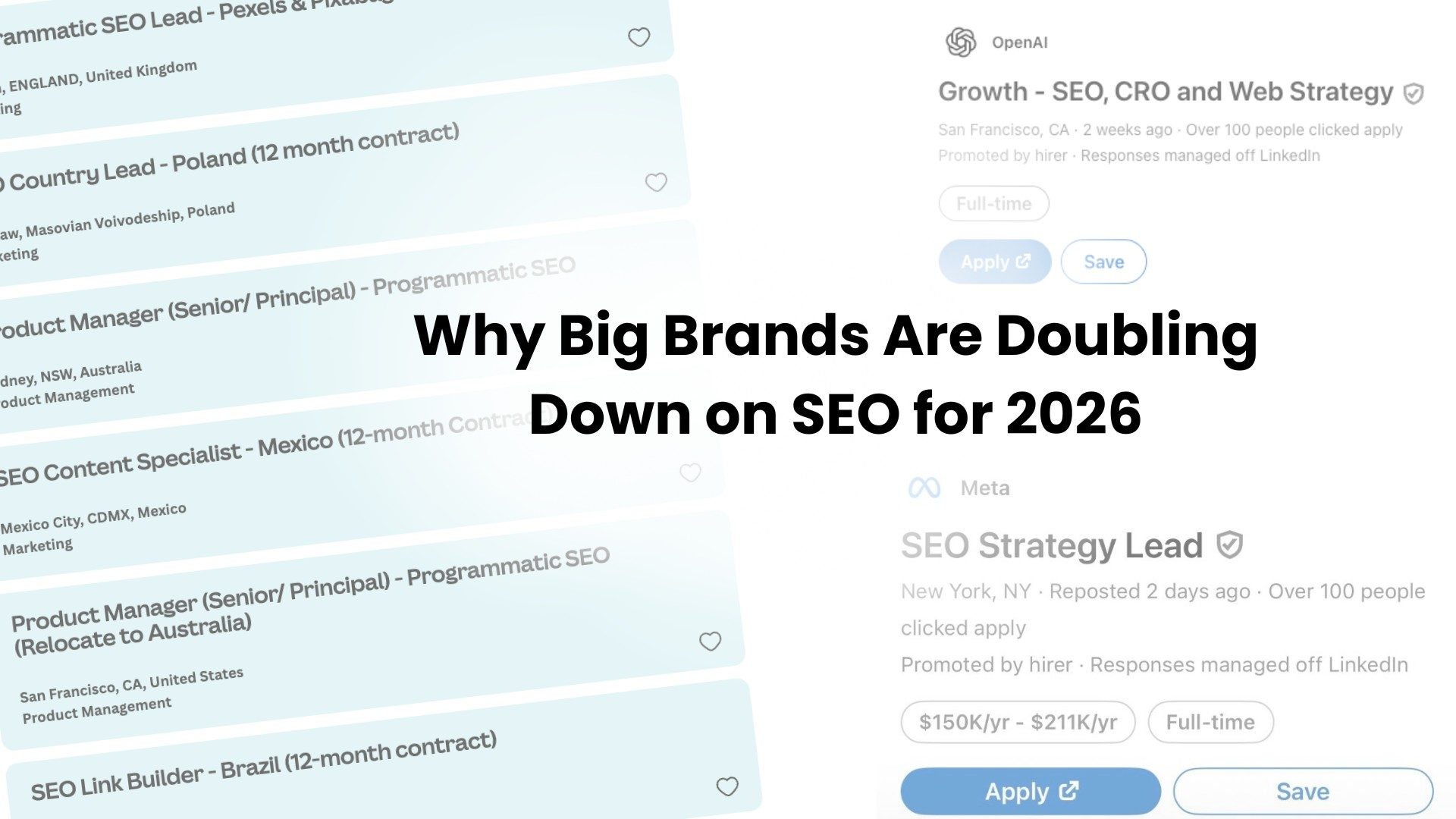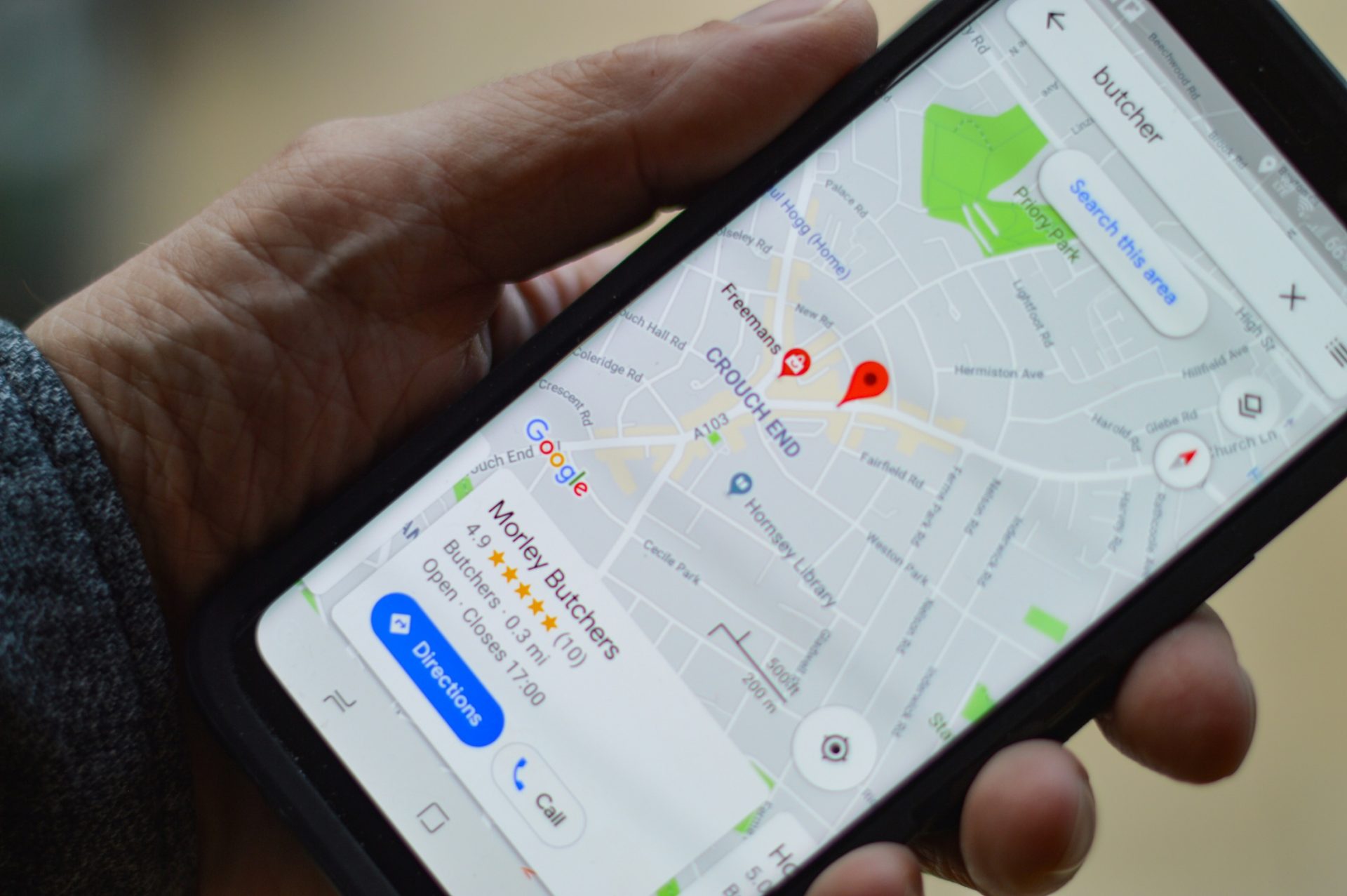Why Big Brands Are Doubling Down on SEO for 2026

In the past few months, some of the world’s biggest companies have made major moves in SEO and content.
Meta, Microsoft, Amazon, and more are all hiring in-house SEO strategists, content leads, and technical SEO specialists, and they’re paying serious salaries to get them.
Doesn’t this contradict the ‘SEO is dead’ narrative flooding our feeds?
The SEO Hiring Surge
If you’ve spent any time on LinkedIn lately, you’ve probably noticed a pattern: big brands are hiring SEO and content talent at a record pace.
In just the past few months alone:
- Meta listed an SEO Strategy Lead position offering US$150,000-$211,000 per year – a senior role sitting within their Global Marketing Science team.
- OpenAI posted a Content Strategist position with a jaw-dropping US$393,000 annual salary, focusing on storytelling, discoverability, and brand clarity.
- Microsoft is hiring an SEO Content Writer.
- Canva continues to expand its internal SEO and Content Operations teams, with SEO Specialist roles typically ranging from US$70,000-$100,000+ globally.
- Amazon has more than a dozen open SEO and organic visibility roles – from Senior SEO Manager to Technical SEO Analyst – many in the US$120,000+ range.
- Even Sportsbet, one of Australia’s most active digital advertisers, is continually growing its internal SEO and content department.
For years, SEO teams inside big corporations were small, sometimes tucked within paid media or PR. But that’s changed. Today, SEO sits at the core of brand strategy, connecting content, product, and growth. These companies are embedding it into every part of how they acquire, nurture, and retain customers.
And the scale of investment says it all. When companies that already dominate the market are willing to pay six-figure salaries for SEO roles, it’s not because they need more traffic; it’s because they understand search visibility equals market control.
Why the Big Players Are Doing It
1. Search Is the Gateway to Every Customer Journey
Even in 2025, the majority of digital journeys still begin with a search, whether that’s Google, YouTube, Amazon, or TikTok’s new in-app results. For brands like Meta, Microsoft, and Canva, controlling how and where they appear in those moments is critical.
By investing in SEO, they’re making sure that when someone searches “AI tools,” “design templates,” or “video editor,” their brand shows up first.
2. Organic Visibility Lowers Long-Term Acquisition Costs
Big brands spend millions each month on paid ads. But those clicks stop the moment the budget pauses. SEO is the opposite, as it builds equity. Every optimised article, landing page, or knowledge hub compounds over time, lowering the effective cost per lead year after year.
Even if Meta spends $200k a year on one additional SEO content strategist, that single hire could save millions in ongoing ad costs by improving discoverability across products and content assets.
3. Content Is Now the Centre of Brand Trust
AI-generated content has flooded the internet and audiences are tuning out. Big brands know that credibility, tone, and authentic human expertise are the differentiators now. That’s why they’re hiring not just “SEO managers,” but content strategists, editorial leads, and digital storytellers who can balance search intent with brand authority.
SEO has evolved from a technical checklist to a trust-building discipline (finally!).
4. SEO Data Powers Smarter Decisions Everywhere
Modern SEO is a rich data source. Search data reveals what customers want, how they think, and where the market is shifting.
Big companies use SEO insights to guide product development, PR narratives, and campaign timing.
For example:
- A spike in “AI resume tools” might prompt a Canva template release.
- Growing searches for “best video editor for TikTok” could guide Microsoft’s Clipchamp roadmap.
- Rising “digital safety” queries could shape Meta’s policy content.
- In other words, SEO is market intelligence.
5. The Algorithm Is Rewarding Depth and Originality Again
After years of chasing backlinks and keyword density, the SEO landscape is maturing. Google’s latest updates (especially in 2024 and 2025) have pivoted toward helpful, experience-driven content.
That’s why large organisations are bringing these skills in-house – they need teams who understand how to create genuinely valuable, human-first content at scale.
What These Salaries Tell Us
So, why are companies like Meta, Microsoft, OpenAI, and Canva willing to pay $150,000–$400,000+ per year, per SEO and content specialist?
Because they’ve finally quantified what the rest of us have known for years: organic visibility drives measurable, compounding ROI.
When a business operates at scale, even small improvements in search performance have massive financial upside. For example:
- A 1% increase in organic click-through rate for a company like Microsoft could equate to millions in additional product sign-ups or software sales.
- For Amazon, a single optimised category page can deliver tens of millions in incremental revenue annually.
- For Canva, ranking first for “resume templates” or “business cards” directly translates to hundreds of thousands of monthly sign-ups.
So, when these companies invest six-figure salaries in SEO, they’re treating it as a revenue-driving growth function. And while the salaries look enormous, they make perfect sense when the ROI is multiplied across millions of users, products, and transactions.
For example, if a $200K-per-year SEO hire improves visibility enough to generate an additional $2M in traffic value, that’s a 10× return – which is exactly why these roles are scaling fast.
What This Means for Smaller Brands
Now, let’s translate that reality into the small-to-medium business world.
You don’t need a $200K in-house SEO lead to benefit from the same principles; you just need to think the same way the big brands do: long-term, strategic, and consistent.
1. See SEO as an Investment, Not a Cost
Big brands are hiring these roles because SEO delivers measurable returns. When small businesses reframe SEO as an asset that appreciates, not an expense that depletes, the whole marketing strategy changes.
Each optimised page, article, or local listing is a “digital property” that can drive leads for years with minimal upkeep.
2. You Can Achieve Enterprise-Level Strategy at SME Scale
Working with an experienced SEO consultant or boutique agency becomes powerful.
For roughly AUD$2,000+ per month ($24K per year), you can have:
- Technical optimisation of your website (the foundation big brands pay full-time staff for)
- A content strategy mapped to your customer journey
- High-impact blog and landing page creation
- Reporting that tracks actual ROI (not just rankings)
That’s the equivalent of having a six-figure SEO team, just fractionalised and focused on your business.
3. Smaller Budgets, Faster Agility
The beauty of being small? You can move quickly. Big brands take months to roll out SEO changes because of bureaucracy, approvals, and layers of management.
A local business can implement the same strategy in a week and see results faster.
That means:
- You can target hyper-local keywords more successfully
- You can respond to search trends as they emerge
- You can pivot faster when Google updates roll out
Your agility is your biggest SEO advantage.
4. Leverage SEO to Future-Proof Your Visibility
Paid channels are only getting more expensive. Google Ads CPCs have increased 15-25% year-on-year in Australia.
An established SEO strategy ensures that your leads don’t disappear the moment your ad budget pauses. And it compounds, so the work you do today will still pay off months (and years) from now.
If Meta and Microsoft are investing millions to reduce their dependency on paid channels, smaller businesses should absolutely be doing the same.
5. Start Small, But Start Now
SEO momentum takes time.
The earlier you start investing in it, the stronger your compounding advantage will be when 2026 truly becomes “the year of SEO and content.”
Big brands are already preparing for that curve.
Smaller businesses have the chance to stay ahead by acting before everyone else catches up.
How Much Should You Invest in SEO?
Most big brands treat SEO as a core investment, not a discretionary expense. Their budgets run into hundreds of thousands (sometimes millions) because they understand that SEO delivers compounding returns.
A practical rule of thumb is that 5–10% of your annual revenue should go toward marketing. Within that, it’s important to allocate enough budget not just for lead generation (like ads or campaigns), but also for SEO and content strategy, the foundation that sustains those leads long term.
This idea of a “sufficient budget” isn’t one-size-fits-all. It depends on your goals, your market, and how competitive your space is.
For example:
- A local service business might start seeing results investing around $1,000-$2,000 per month with a commercial agency.
- A regional or national brand competing in a crowded market may need $3,000-$5,000+ per month to afford enough support from a dedicated specialist or boutique team.
- E-commerce and high-growth brands often scale higher as content, backlinks, and product visibility expand, requiring more time from their strategists.
But the key is how consistently you invest. One-off bursts rarely move the needle. Long-term, structured investment builds equity that compounds over time.
Big brands know this, that’s why SEO sits beside sales and product as a permanent budget line, not an afterthought.
The ROI Equation
SEO’s power lies in compounding value. I often show this chart to all my clients before we start:

I make sure my clients calculate some KPIs for me to hit in how much organic search is driving enquiries/bookings/sales to their business.
Let’s run an example. Starting backwards, if an average customer brings in $2,000 and your profit margin is 40%, that’s $800 in profit per sale. If you’re paying $2,500 per month for SEO, you’ll need just over three new jobs per month to break even.
If you think about how many enquiries translate into ‘jobs’, it’ll likely look like 1 in 5 (give or take). So you’d need approximately 15 leads generated per month for SEO to cover its cost.
For the first few months, you’ll likely see this KPI not being met. But as results compound, the ROI will not just be 1:1 (breaking even), it’ll continue to grow.
This also means less money on lead gen and ads, more stable cash flow to scale your business, and strategists on your team helping your business stay one step ahead of your competitors.
Start 2026 With Traction
The world’s biggest brands aren’t suddenly investing in SEO because it’s trendy. They’ve realised that organic visibility compounds, brand trust drives conversions, and content is the thread connecting every marketing channel.
When companies like Meta, Canva, and Microsoft are paying six-figure salaries for SEO specialists, it is clear that they’re building durable growth.
And while small businesses may not match those budgets, they can absolutely apply the same principles: consistency, expertise, and strategy.
If you’re ready to turn SEO from a line item into a long-term growth engine, let’s map out the strategy that fits your goals, your budget, and your business. Book a free consultation with me to get started!



